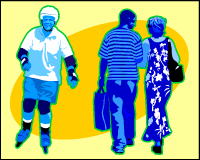Pavement Etiquette
Created | Updated Nov 14, 2006

The rules of pavement etiquette have evolved from the frustration of two main groups of pedestrians: The slower, less mobile pedestrians who feel that they are not treated with the care and respect of their fellow pavement users; and the fast moving pedestrians who are constantly obstructed by slower or discourteous pedestrians and others who share the same pavement (also know as the sidewalk in many countries including the USA and Canada).
Pavement etiquette is a set of guidelines, not hard-fast rules (like table manners) that vary slightly depending on what city you are visiting. They are developed as a reminder that although in many countries you are free to act however you like (within certain limits), there is a polite way of sharing a sidewalk with your fellow humans.
Some Guidelines of Pavement Etiquette
When walking down the pavement it is normally polite for the slower traffic to walk towards the edge of the pavement and for the faster walkers to pass towards the middle. (like driving)
When two or more people walking abreast on the pavement approach a single pedestrian, it is proper for the two people to provide enough room for the other pedestrian to pass without having to walk off the sidewalk into the mud or road.
It is never polite to walk very quickly to pass another person only to stop directly in front of them leaving no time/opportunity for them to avoid collision.
It is also not correct to use a baby's buggy to push other pedestrians off the pavement.
When using wheeled method of transportation on the pavement (which is illegal in many cities) it is often best to make some noise so that others sharing the pavement can move out of the way.
It is very important to be careful towards the less mobile members of pavement users. This includes, but is not limited to, the elderly part of our population. Due to this, it is very important for others sharing the pavement with them to be conscious of this and to be extra cautious and respectful towards these individuals (in other words, please don't knock over anyone's grandmother with their shopping bags just because you're in a hurry).
Keep an eye out for other pedestrians when making sudden moves from one side to the other, (ie from the curb to the shop) especially in busy situations. By being conscious of where other people are you can often avoid collisions with them. Many people find it annoying to be collided into by other people. It may help to keep them in a good mood by preventing this.
Old-fashioned etiquette suggested that, if a gentleman were accompanying a lady, he would position himself between her and the road, to protect her from any spray and so on thrown up by passing cars. Another theory suggests that this is to do with chamber pots and trash being disposed of in the streets (pre-pavement days); compounding that with the enormous time (lace and embroidery) and expense of women's garments. Although, of course, in London these days, there's a certain weight to the argument that he should position himself on the other side to take the responsibility of handling negotiations with anyone manifesting themselves from a doorway and asking for money...
Many countries have unspoken recommendations for which side of the pavement you walk on. For example in Canada it is believed that if one is facing traffic they should walk on the pavement opposite the direction of vehicle travel nearest the curb. In Japan one typically walks on the left side of the pavement regardless of direction of travel, unless passing another person.
In many countries it is not polite to drive a car on the pavement no matter how big it is (the pavement not the car). Also, if you see someone who is tempted to park their car on the pavement you may want to dissuade them. A relatively new device known as a Segway (Niles rode one in an episode of Frasier) has recently been spotted on pavements around the world. Please note that at the time of writing, it is not legal to use one of these on the pavement in the UK.
Other Ideas for Improving Pavement Flow
There has been a growing concern by officials on how to improve the flow of pedestrians in crowded situations, for example Oxford Street in London, or busy down town New York City. Some suggestions are:
Limit the amount of automobile traffic to certain times of day and places, allowing more freedom for walking.
Dedicate all streets in the downtown core for walking only (except morning delivery trucks) and create cheaper parking to facilitate this.
Widen the width of pavements to create more room.
Designate a special lane for faster moving foot traffic.
Some of these have been tried successfully in some cities, and some have been tried without success.
In Conclusion
Just remember that we are all in this together, if we are kind to one another we can create an efficient and prosperous mode of transportation out of what is often a mess of confused pedestrians milling about on our pavement.

